tow CHEVROLET PRIZM 1998 3.G Owners Manual
[x] Cancel search | Manufacturer: CHEVROLET, Model Year: 1998, Model line: PRIZM, Model: CHEVROLET PRIZM 1998 3.GPages: 364, PDF Size: 18.79 MB
Page 41 of 364
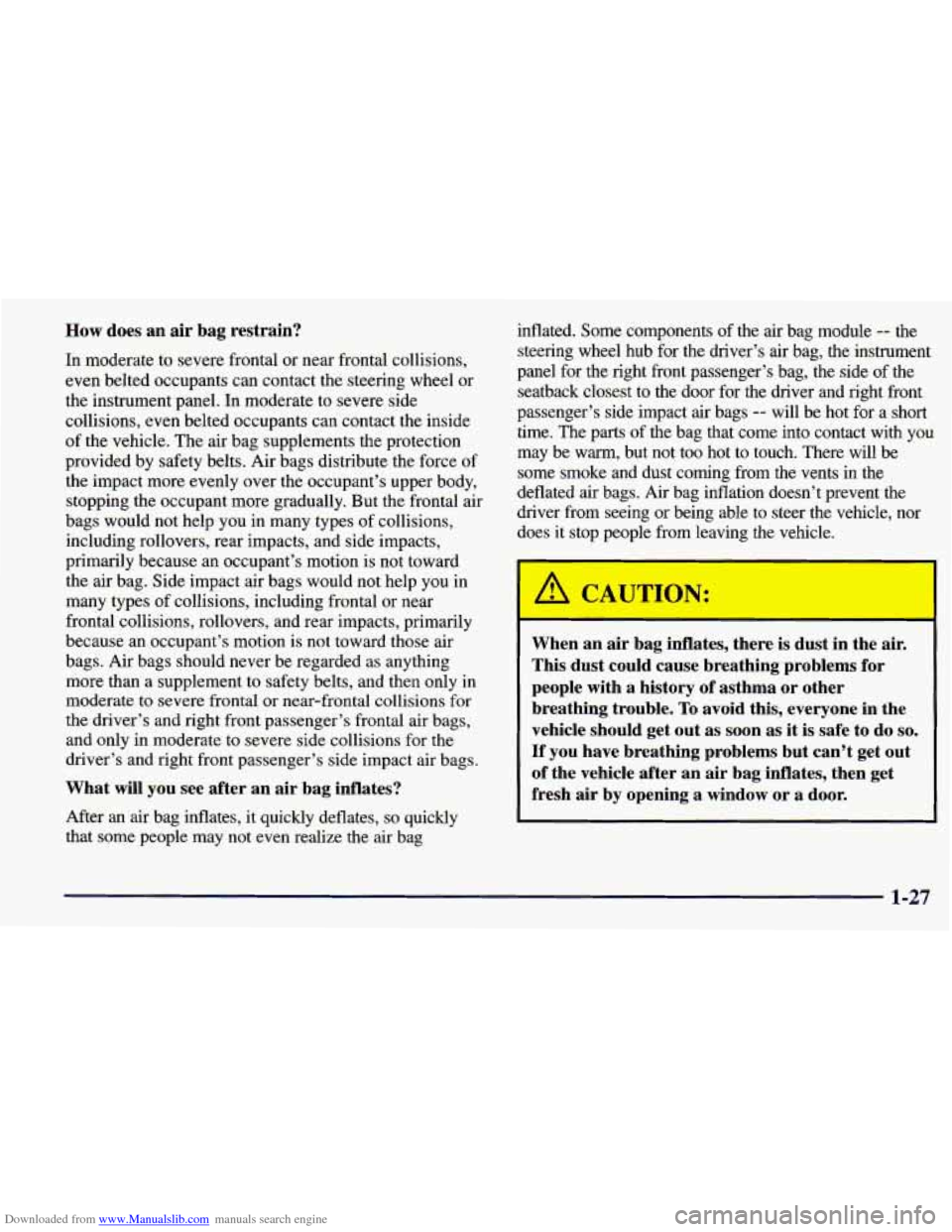
Downloaded from www.Manualslib.com manuals search engine How does an air bag restrain?
In moderate to severe frontal or near frontal collisions,
even belted occupants can contact the steering wheel or
the instrument panel. In moderate to severe side
collisions, even belted occupants can contact the inside
of the vehicle. The air bag supplements the protection
provided by safety belts. Air bags distribute the force of
the impact more evenly over the occupant’s upper body,
stopping the occupant more gradually. But the frontal air
bags would not help you in many types of collisions,
including rollovers, rear impacts, and side impacts,
primarily because an occupant’s motion is not toward
the air bag. Side impact air bags would not help you in
many types of collisions, including frontal or near
frontal collisions, rollovers, and rear impacts, primarily
because an occupant’s motion is not toward those air
bags. Air bags should never be regarded as anything
more than a supplement to safety belts, and then only in
moderate to severe frontal or near-frontal collisions for
the driver’s and right front passenger’s frontal air bags,
and only in moderate to severe side collisions for the
driver’s and right front passenger’s side impact air bags.
What will you see after an air bag inflates?
After an air bag inflates, it quickly deflates, so quickly
that some people may not even realize
the air bag inflated. Some components
of the
air bag module -- the
steering wheel hub for the driver’s air bag, the instrument
panel for
the right front passenger’s bag, the side of the
seatback closest to the door for the driver and right front
passenger’s side impact air bags
-- will be hot for a short
time. The parts of the bag that come into contact with you
may be warm, but not too hot to touch. There will be
some smoke and dust coming from the vents in the
deflated air bags. Air bag inflation doesn’t prevent the
driver from seeing or being able to steer the vehicle, nor
does it stop people from leaving the vehicle.
A CAUTION:
When an air bag inflates, there is dust in the air.
This dust could cause breathing problems for
people with a history of asthma or other breathing trouble.
To avoid this, everyone in the
vehicle should get out as soon
as it is safe to do so.
If you have breathing problems but can’t get out
of the vehicle after an air bag inflates, then get
fresh air by opening a window or
a door.
1-27
Page 43 of 364
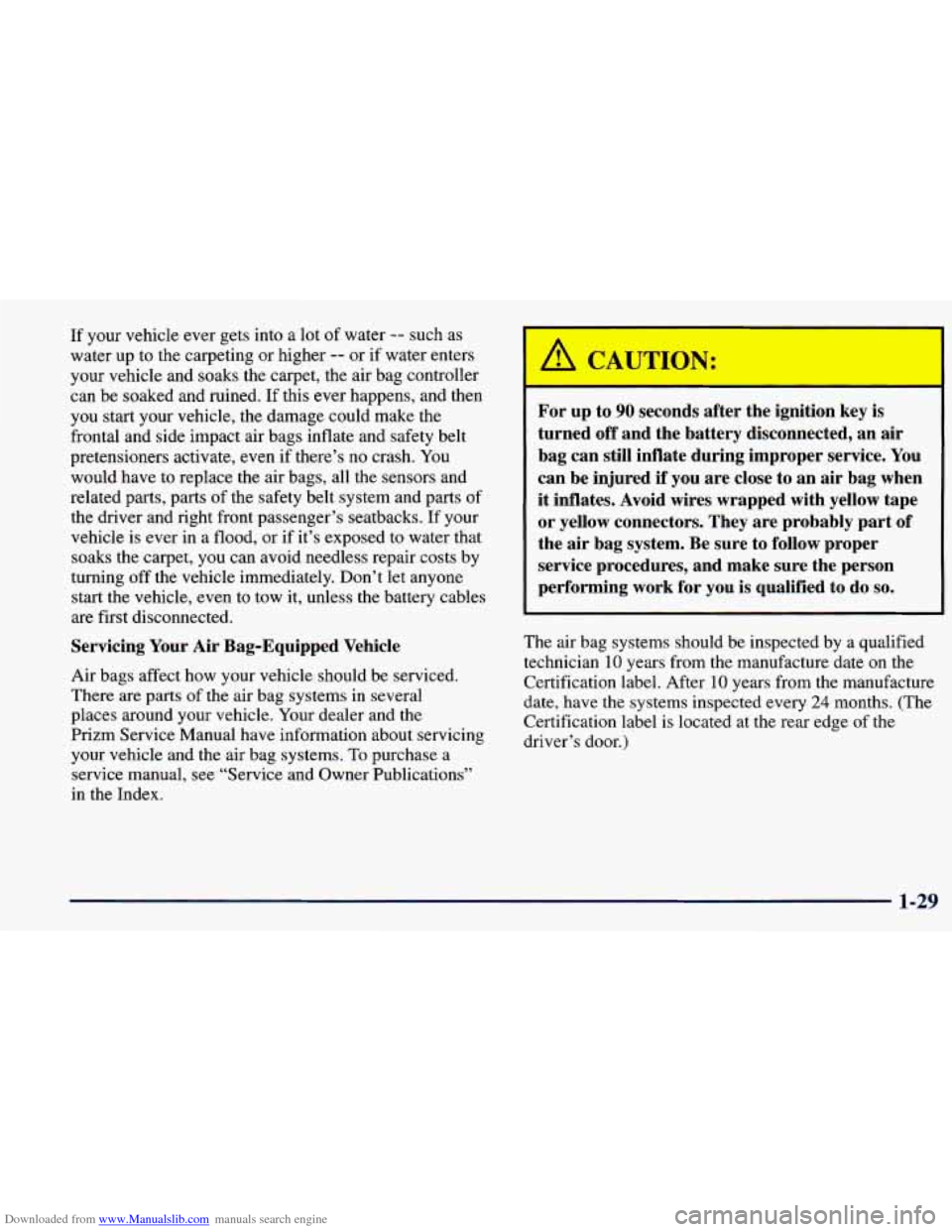
Downloaded from www.Manualslib.com manuals search engine If your vehicle ever gets into a lot of water -- such as
water up to the carpeting or higher
-- or if water enters
your vehicle and soaks the carpet, the air bag controller
can be soaked and ruined. If this ever happens, and then
you start your vehicle, the damage could make the
frontal and side impact air bags inflate and safety belt
pretensioners activate, even if there’s
no crash. You
would have to replace the air bags, all the sensors and
related parts, parts of the safety belt system and parts of
the driver and right front passenger’s seatbacks.
If your
vehicle is ever in a flood, or if it’s exposed to water that
soaks the carpet, you can avoid needless repair costs by
turning off the vehicle immediately. Don’t let anyone
start the vehicle, even to tow it, unless the battery cables
are first disconnected.
Servicing Your Air Bag-Equipped Vehicle
Air bags affect how your vehicle should be serviced.
There are parts of the air bag systems in several
places around your vehicle. Your dealer and the
Prizm Service Manual have information about servicing
your vehicle and the air bag systems. To purchase a
service manual, see “Service and Owner Publications”
in the Index.
1
For up to 90 seconds after the ignition key is
’ turned off and the battery disconnected, an air
bag can still inflate during improper service. You
can be injured if you are close to an air bag when
it inflates. Avoid wires wrapped with yellow tape
or yellow connectors. They are probably part of
the air bag system. Be sure to follow proper
service procedures, and make sure the person
performing work for you is qualified to do
so.
The air bag systems should be inspected by a qualified
technician
10 years from the manufacture date on the
Certification label. After
10 years from the manufacture
date, have the systems inspected every
24 months. (The
Certification label is located at the rear edge of the
driver’s door.)
1-29
Page 63 of 364
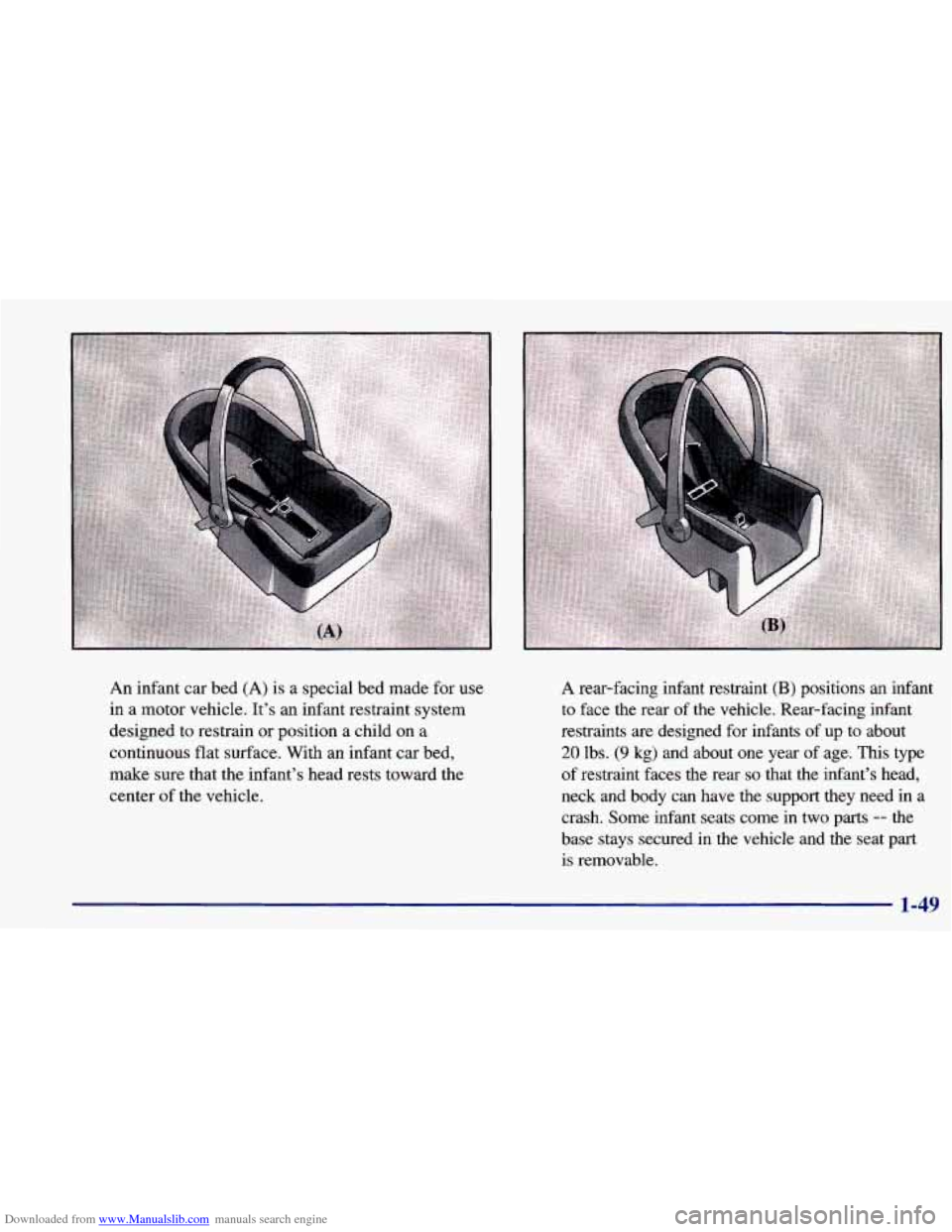
Downloaded from www.Manualslib.com manuals search engine An infant car bed (A) is a special bed made for use
in a motor vehicle. It’s an infant restraint system
designed to restrain or position a child on a
continuous flat surface. With an infant car bed,
make sure that the infant’s head rests toward the
center of the vehicle.
A rear-facing infant restraint (B) positions an infant
to face the rear of the vehicle. Rear-facing infant
restraints
are designed for infants of up to about
20 lbs. (9 kg) and about one year of age. This type
of restraint faces the rear
so that the infant’s head,
neck and body can have the support they need in a crash. Some infant seats come in two
parts -- the
base stays secured in the vehicle and the seat
part
is removable.
1-49
Page 73 of 364
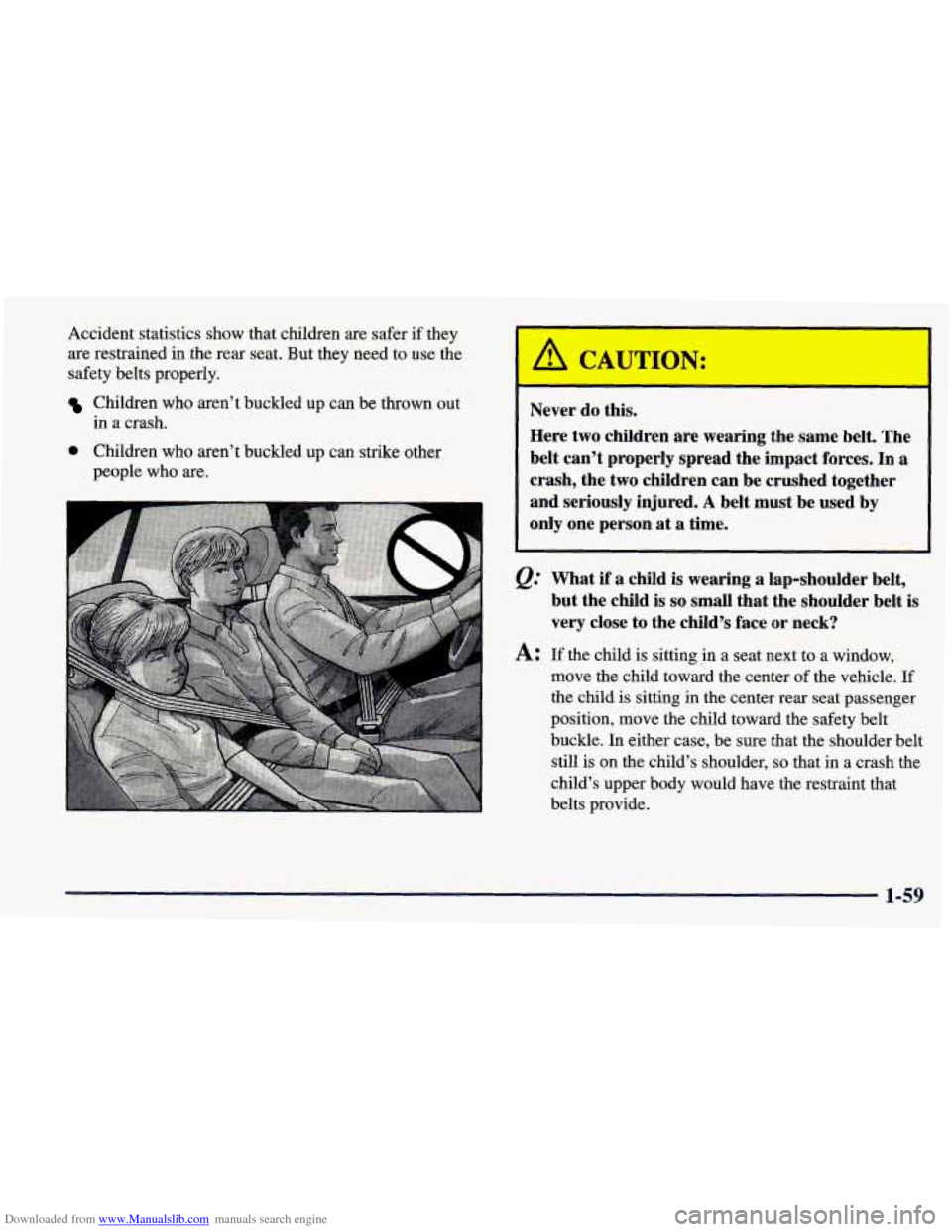
Downloaded from www.Manualslib.com manuals search engine Accident statistics show that children are safer if they
are restrained in the rear seat. But they need to use the
safety belts properly.
Children who aren’t buckled up can be thrown out
0 Children who aren’t buckled up can strike other
in
a crash.
people who are.
Never do this.
Here two children
are wearing the same belt. The
belt can’t properly spread the impact forces. In a
crash, the two children can be crushed together
and seriously injured.
A belt must be used by
only one person at a time.
What
if a child is wearing a lap-shoulder belt,
but the child is
so small that the shoulder belt is
very close to the child’s face or neck?
A: If the child is sitting in a seat next to a window,
move the child toward
the center of the vehicle. If
the child is sitting in the center rear seat passenger
position, move the child toward the safety belt
buckle. In either case, be sure that the shoulder belt
still is on the child’s shoulder,
so that in a crash the
child’s upper body would have the restraint that
belts provide.
1-59
Page 82 of 364
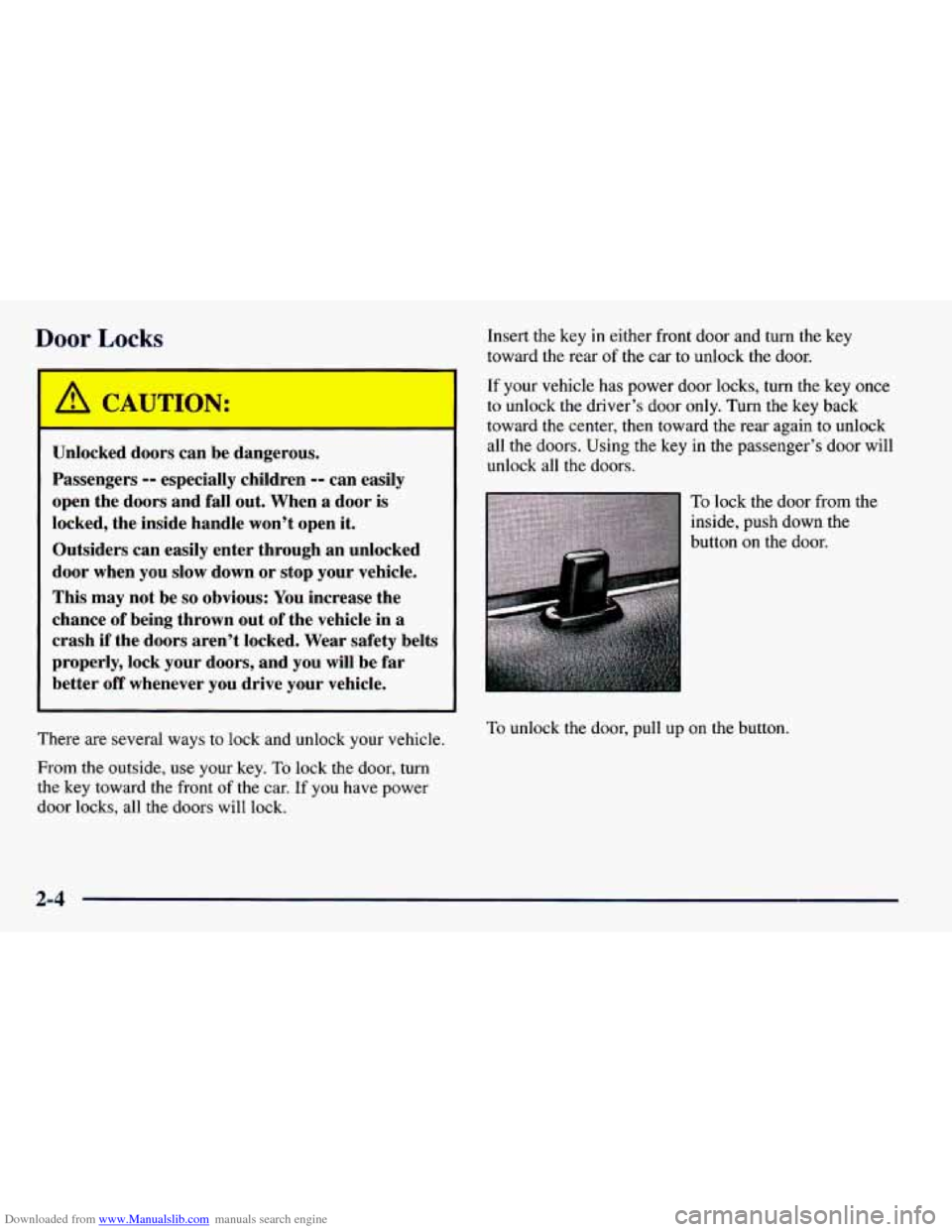
Downloaded from www.Manualslib.com manuals search engine Door Locks
Irn
Unlocked doors can be dangerous.
Passengers
-- especially children -- can easily
open the doors and fall out. When a door is
locked, the inside handle won’t open it.
Outsiders can easily enter through an unlocked
door when
you slow down or stop your vehicle.
This may not be
so obvious: You increase the
chance of being thrown out of the vehicle in a
crash if the doors aren’t locked. Wear safety belts
properly, lock your doors, and you will be
far
better off whenever you drive your vehicle.
Insert the key in either front door and turn the key
toward the rear
of the car to unlock the door.
If your vehicle has power door locks, turn the key once
to unlock the driver’s door only. Turn the key back
toward
the center, then toward the rear again to unlock
all the
doors. Using the key in the passenger’s door will
unlock all the doors.
To lock the door from the
inside, push down the
button on the door.
There are several ways
to lock and unlock your vehicle.
From the outside, use your key. To lock the door, turn
the key toward the front of the car. If you have power
door locks, all the doors will lock.
To unlock the door, pull up on the button.
2-4
Page 89 of 364
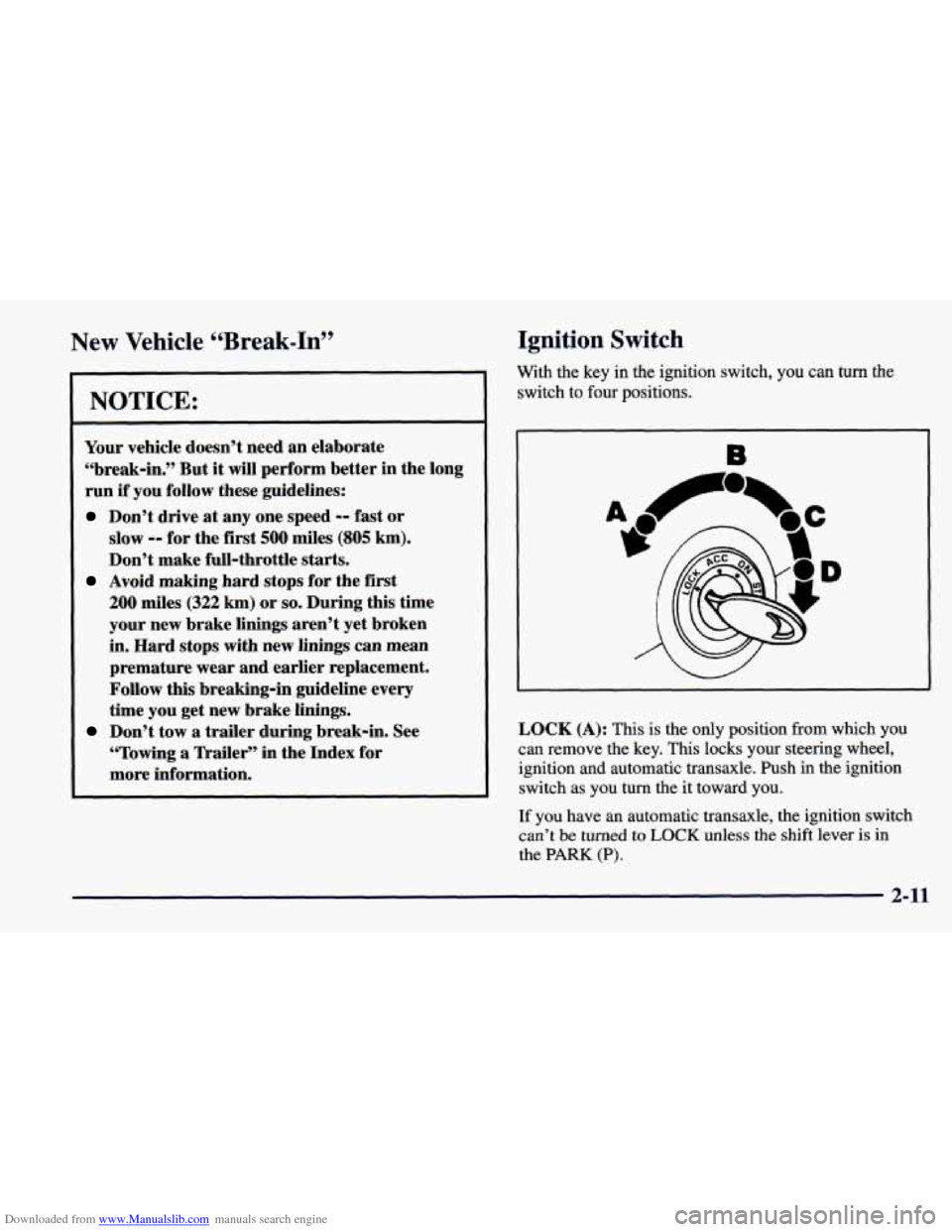
Downloaded from www.Manualslib.com manuals search engine New Vehicle “Break-In”
NOTICE:
Your vehicle doesn’t need an elaborate
“break-in.” But it will perform better in the long
run
if you follow these guidelines:
Don’t drive at any one speed -- fast or
slow
-- for the first 500 miles (805 km).
Don’t make full-throttle starts.
200 miles (322 km) or so. During this time
your new brake linings aren’t yet broken
in. Hard stops with new linings can mean
premature wear and earlier replacement.
Follow this breaking-in guideline every
time you get new brake linings.
Don’t tow a trailer during break-in. See
“Towing a Trailer” in the Index for
more information.
Avoid making hard stops for the first
Ignition Switch
With the key in the ignition switch, you can turn the
switch to
four positions.
W
LOCK (A): This is the only position from which you
can remove the key. This locks your steering wheel,
ignition and automatic transaxle.
Push in the ignition
switch as you
turn the it toward you.
If you have an automatic transaxle, the ignition switch
can’t be turned to
LOCK unless the shift lever is in
the
PARK (P).
Page 92 of 364
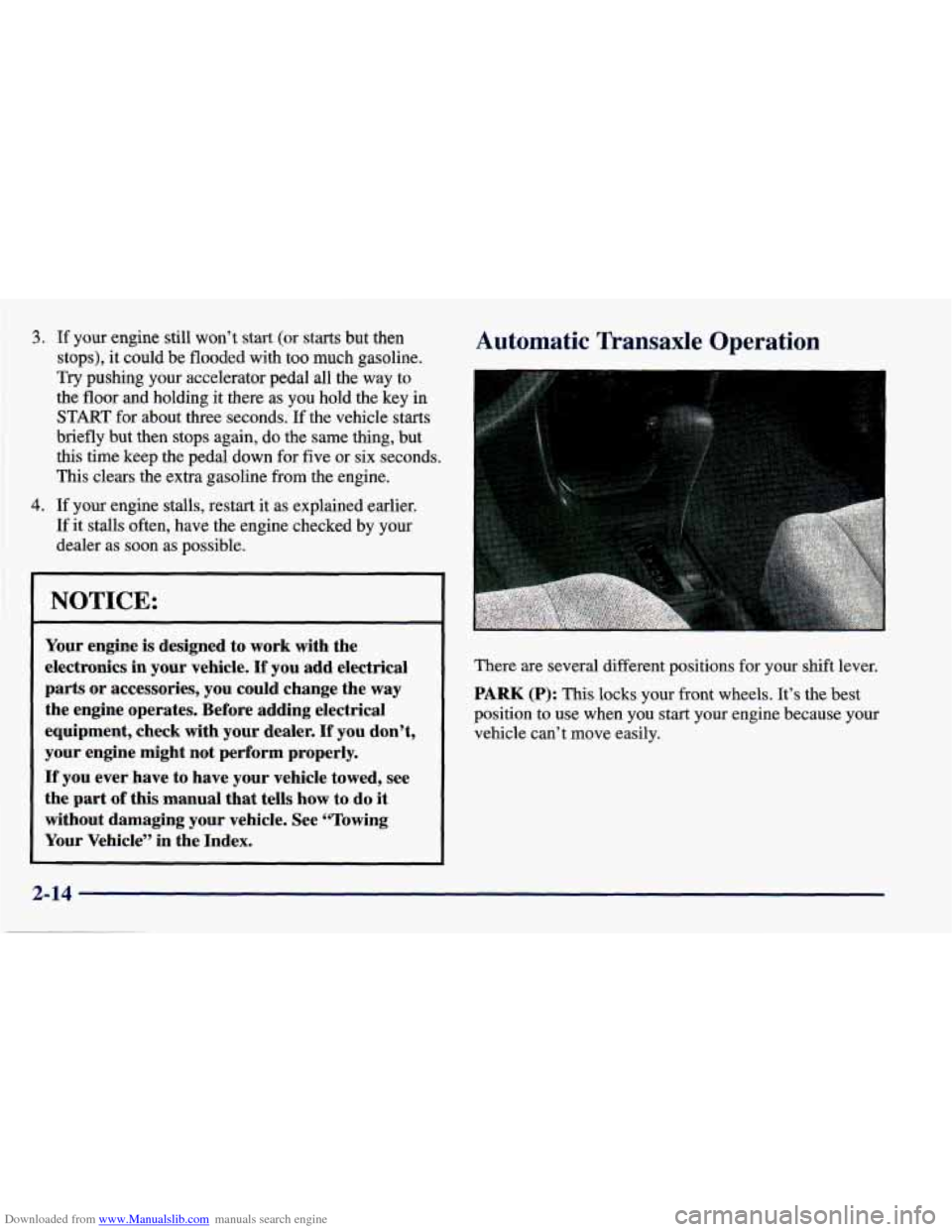
Downloaded from www.Manualslib.com manuals search engine 3. If your engine still won’t start (or starts but then
stops), it could be flooded with too much gasoline.
Try pushing your accelerator pedal all the way to
the floor and holding it there as you hold the key in
START for about three seconds. If the vehicle starts
briefly but then stops again, do the same thing, but
this time keep the pedal down for five or six seconds.
This clears the extra gasoline from the engine.
4. If your engine stalls, restart it as explained earlier.
If it stalls often, have the engine checked by your
dealer as soon as possible.
NOTICE:
Your engine is designed to work with the
electronics in your vehicle.
If you add electrical
parts or accessories, you could change the
way
the engine operates. Before adding electrical
equipment, check with your dealer.
If you don’t,
your engine might not perform properly.
If you ever have to have your vehicle towed, see
the
part of this manual that tells how to do it
without damaging your vehicle. See “Towing
Your Vehicle’’ in the Index.
Automatic Transaxle Operation
There are several different positions for your shift lever.
PARK (P): This locks your front wheels. It’s the best
position to use when
you start your engine because your
vehicle can’t
move easily.
Page 93 of 364
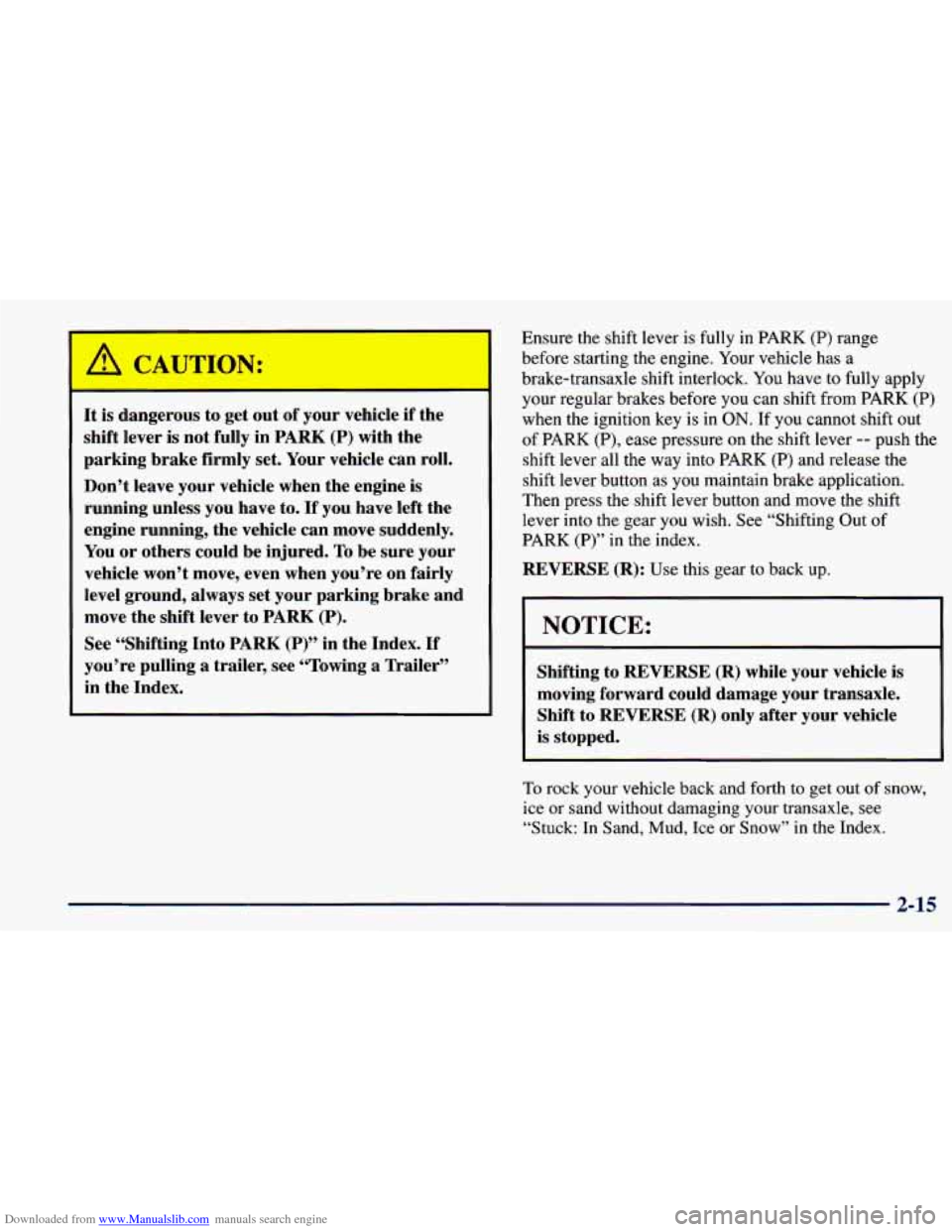
Downloaded from www.Manualslib.com manuals search engine It is dangc- JUS to get out of your vehicle if the
shift lever
is not fully in PARK (P) with the
parking brake firmly set. Your vehicle can roll.
Don’t leave your vehicle when the engine is
running unless you have to.
If you have left the
engine running, the vehicle can move suddenly.
You or others could be injured.
To be sure your
vehicle won’t move, even when you’re
on fairly
level ground, always set your parking brake and
move the shift lever to
PARK (P).
you’re pulling a trailer, see “Towing a Trailer’’
~ See “Shifting Into PARK (P)” in the Index. If
~ in the Index.
Ensure the shift lever is fully in PARK (P) range
before starting the engine. Your vehicle has
a
brake-transaxle shift interlock. You have to fully apply
your regular brakes before you can shift from
PARK (P)
when the ignition key is in ON. If you cannot shift out
of PARK (P), ease pressure on the shift lever -- push the
shift lever all the way into PARK
(P) and release the
shift lever button as you maintain brake application.
Then press the shift lever button and move the shift
lever into the gear you wish. See “Shifting Out of
PARK (P)” in the index.
REVERSE (R): Use this gear to back up.
NOTICE:
Shifting to REVERSE (R) while your vehicle is
moving forward could damage your transaxle.
Shift to
REVERSE (R) only after your vehicle
is stopped.
To rock your vehicle back and forth to get out of snow,
ice or sand without damaging your transaxle, see
“Stuck: In Sand,
Mud, Ice or Snow” in the Index.
2-15
Page 94 of 364
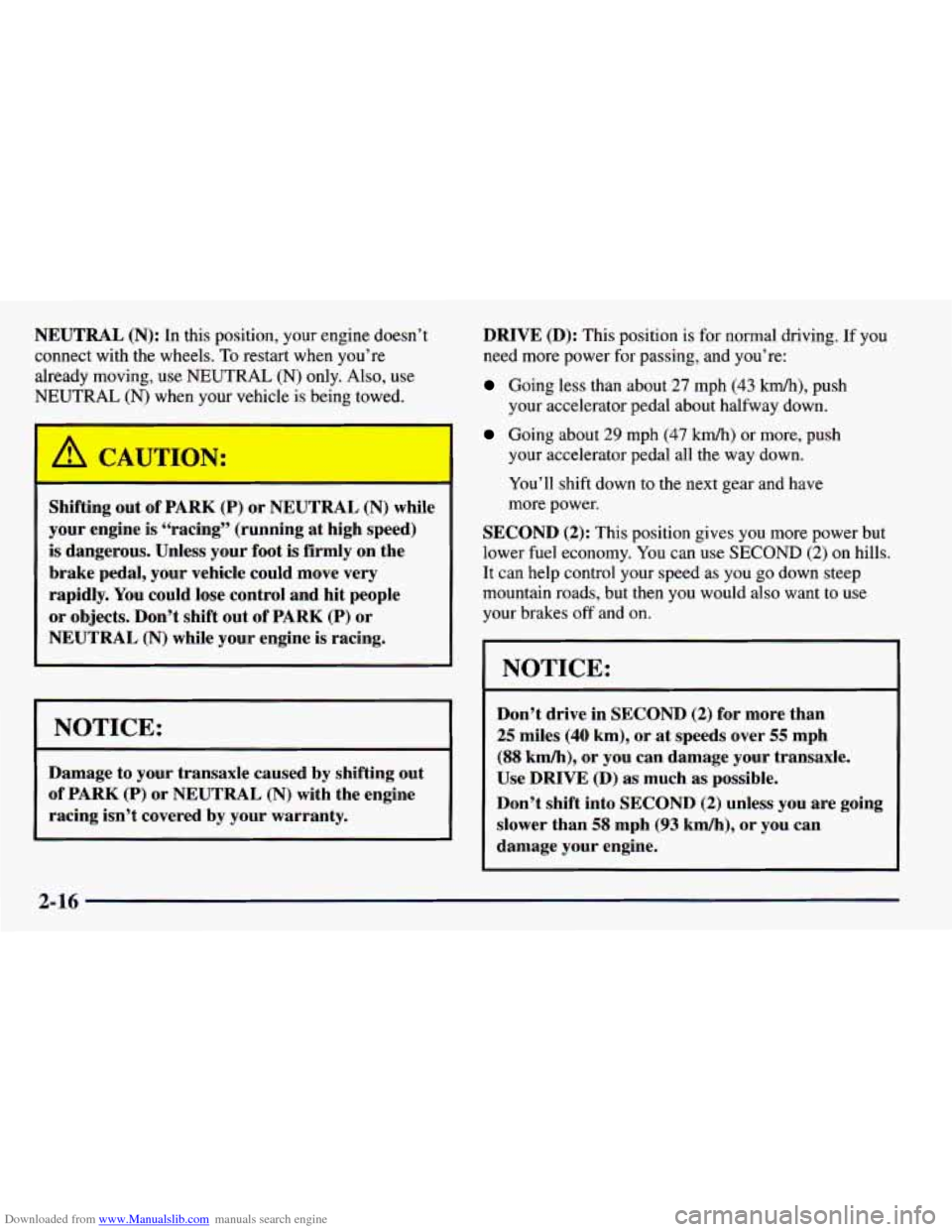
Downloaded from www.Manualslib.com manuals search engine NEUTRAL (N): In this position, your engine doesn’t
connect with the wheels.
To restart when you’re
already moving,
use NEUTRAL (N) only. Also, use
NEUTRAL (N) when your vehicle is being towed.
Shifting out of PARK (P) or NEUTRAL (N) while
your engine is “racing” (running at high speed)
is dangerous. Unless your foot
is firmly on the
brake pedal, your vehicle could move very
rapidly. You could lose control and hit people
or objects. Don’t shift out of PARK (P) or
NEUTRAL
(N) while your engine is racing.
NOTICE:
Damage to your transaxle caused by shifting out
of PARK
(P) or NEUTRAL (N) with the engine
racing isn’t covered by your warrantv. DRIVE (D):
This
position is for normal driving. If you
need more power for passing, and you’re:
Going less than about 27 mph (43 M), push
your accelerator pedal about halfway down.
Going about 29 mph (47 kmh) or more, push
your accelerator pedal all the way down.
You’ll shift down to the
next gear and have
more power.
SECOND (2): This position gives you more power but
lower fuel economy.
You can use SECOND (2) on hills.
It can help control your speed as you go down steep
mountain roads, but then you would also want to use
your brakes
off and on.
-- ~~
NOTICE:
Don’t drive in SECOND (2) for more than
25 miles (40 km), or at speeds over 55 mph
(88 kmh), or you can damage your transaxle.
Use DRIVE (D) as much as possible.
Don’t shift into SECOND
(2) unless you are going
slower than
58 mph (93 km/h), or you can
damage your engine.
2-16
Page 99 of 364
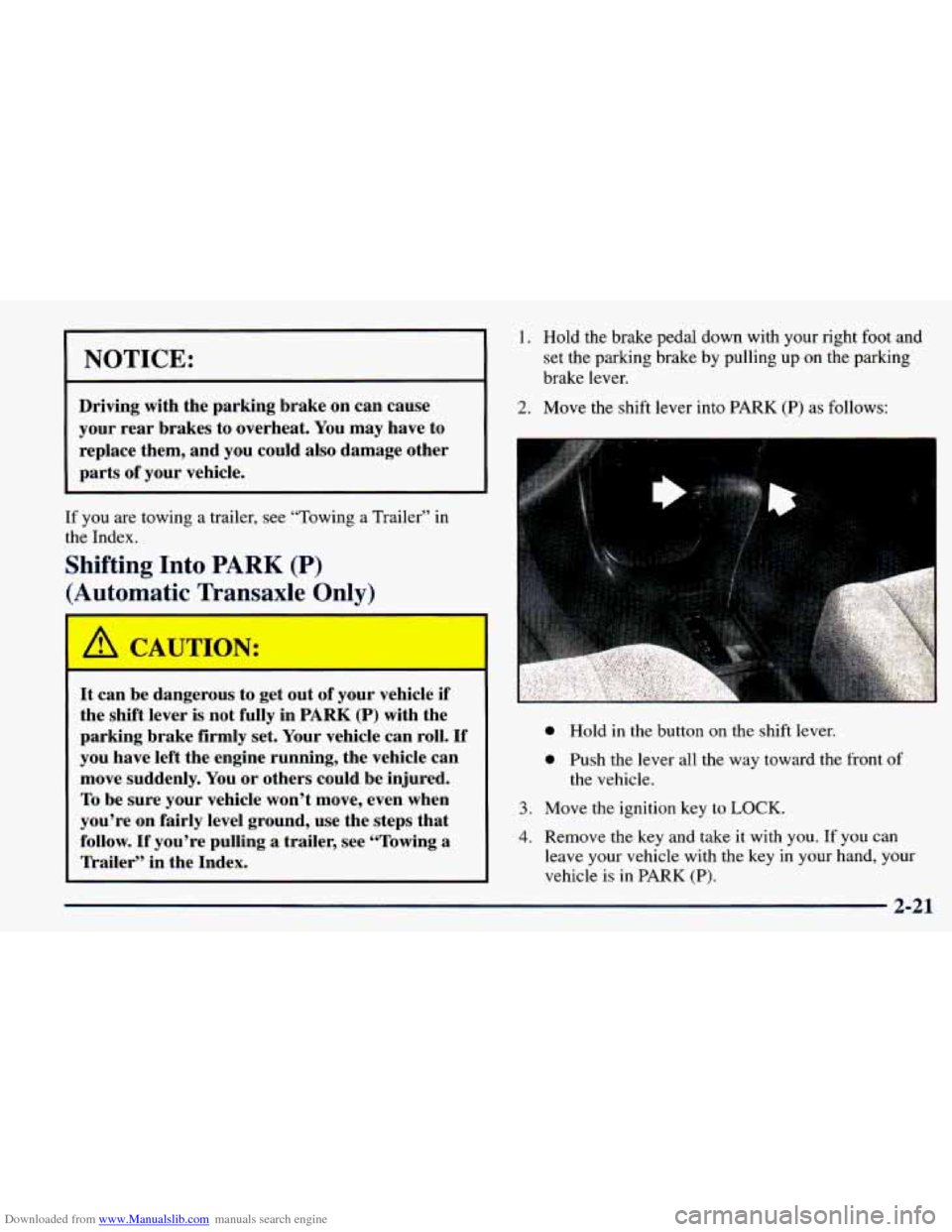
Downloaded from www.Manualslib.com manuals search engine NOTICE:
Driving with the parking brake on can cause
your rear brakes to overheat. You may have to
replace them, and you could also damage other
parts of your vehicle.
If you are towing a trailer, see “Towing a Trailer” in
the Index.
Shifting Into PARK (P)
A
It can be dangerous to get out of your vehicle if
the shift lever is not fully in
PARK (P) with the
parking brake firmly set. Your vehicle can roll.
If
you have left the engine running, the vehicle can
move suddenly. You or others could be injured.
To be sure your vehicle won’t move, even when
you’re on fairly level ground, use the steps that
follow.
If you’re pulling a trailer, see “Towing a
Trailer” in the Index.
1. Hold the brake pedal down with your right foot and
set the parking brake by pulling up on the parking
brake lever.
2. Move the shift lever into PARK (P) as follows:
I
0 Hold in the button on the shift lever.
0 Push the lever all the way toward the front of
the vehicle.
3. Move the ignition key to LOCK.
4.
Remove the key and take it with you. If you can
leave your vehicle with
the key in your hand, your
vehicle is
in PARK (P).
2-21